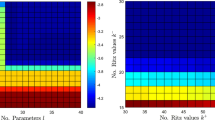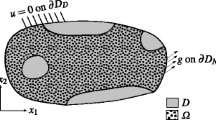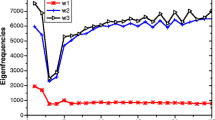Abstract
An issue that frequently arises in structural optimization problems considering eigenvalues is the non differentiability of repeated eigenvalues. In order to overcome this difficulty, several schemes were already presented in the literature. However, these approaches generally have other disadvantages such as the inclusion of additional constraints, the inaccuracy of representation of smallest/largest eigenvalues, the significant increase in the computational effort required and incompatibility with finite differences schemes. In this paper a smooth p-norm approximation for the smallest magnitude eigenvalue is employed. The resulting approximation is differentiable, converges to the exact value as p is increased and is very simple to use (it is also compatible with finite difference schemes). Although the use of smooth approximations for maximum/minimum operators is a classical approach, for some reason it was not extensively studied in the context of structural optimization considering eigenvalues. Three examples concerning topology optimization for the maximization of the first natural vibration frequency of plane stress structures are presented in order to show the effectiveness of the proposed approach.


















Similar content being viewed by others
References
Bathe KJ (1996) Finite element procedures. Prentice-Hall, Upper Sadle River
Bendsøe MP, Sigmund O (2003) Topology optimization: theory, methods and applications. Springer, Berlin
Chang K (1992) Optimality criteria methods using k-s functions. Struct Optim 4(3):213–217
Chen X, Qi H, Qi L, Teo K (2004) Smooth convex approximation to the maximum eigenvalue function. J Global Optim 30(2):253–270
Du J, Olhoff N (2007) Topological design of freely vibrating continuum structures for maximum values of simple and multiple eigenfrequencies and frequency gaps. Struct Multidiscip Optim 34(2):91–110
Gravesen J, Evgrafov A, Nguyen DM (2011) On the sensitivities of multiple eigenvalues. Struct Multidiscip Optim 44(4):583–587
Haftka RT, Gürdal Z (1992) Elements of structural optimization, 3rd edn. Kluwer, Dordrecht
Jensen JS, Pedersen NL (2006) On maximal eigenfrequency separation in two-material structures: the 1d and 2d scalar cases. J Sound Vib 289(4–5):967–986
Kato T (1995) Perturbation theory for linear operators. Springer, Berlin
Koĉvara M (2002) On the modelling and solving of the truss design problem with global stability constraints. Struct Multidiscip Optim 23(3):189–203
Kreisselmeier G, Steinhauser R (1979) Systematic control design by optimizating a vector performance index. In: Cuenod MA (ed) Proceedings of the IFAC symposium on computer aided design of control systems, Zurich, pp 113–117
Le C, Norato J, Bruns T, Ha C, Tortorelli D (2010) Stress-based topology optimization for continua. Struct Multidiscip Optim 41(4):605–620
Lee E, James K, Martins J (2012) Stress-constrained topology optimization with design-dependent loading. Struct Multidiscip Optim 46(5):647–661
Ma ZD, Kikuchi N, Cheng HC (1995) Topological design for vibrating structures. Comput Methods Appl Mech Eng 121(1–4):259–280
Nguyen DM, Evgrafov A, Gersborg AR, Gravesen J (2011) Isogeometric shape optimization of vibrating membranes. Comput Methods Appl Mech Eng 200(13–16):1343–1353
Ohsaki M, Fujisawa K, Katoh N, Kanno Y (1999) Semi-definite programming for topology optimization of trusses under multiple eigenvalues constraints. Comput Methods Appl Mech Eng 180(1–2):203–217
Pedersen NL (2000) Maximization of eigenvalues using topology optimization. Struct Multidiscip Optim 20(1):2–11
Pedersen NL, Nielsen AK (2003) Optimization of practical trusses with constraints on eigenfrequencies, displacements, stresses, and buckling. Struct Multidiscip Optim 25(5–6):436–445
Pedersen P (1994) Non-conservative dynamic systems: analysis, sensitivity analysis, optimization. In: Olhof N (ed) Lecture notes from IUTAM 5-th summer school on mechanics, Concurrent engineering tools for dynamic analysis and optimization. Aalborg University, Aalborg
Quarteroni A, Sacco R, Saleri F (2007) Numerical mathematics, 2nd edn. Springer, Berlin
Rellich P (1954) Perturbation theory of eigenvalue problems. New York University, Tech. rep, New York
Seyranian AP, Lund E, Olhoff N (1994) Multiple eigenvalues in structural optimization problems. Struct Optim 8(4):207–227
The MathWorks, Inc (2015) Optimization toolbox user’s guide. http://www.mathworks.com/help/pdf_doc/optim/optim_tb.pdf. Retrieved 13 Mar 2015
Torii AJ, Lopez RH, Miguel LFF (2014) Modeling of global and local stability in optimization of truss-like structures using frame elements. Struct Multidiscip Optim 51(6):1187–1198
Yang R, Chen C (1996) Optimality criteria methods using k-s functions. Struct optim 12(2):98–105
Acknowledgments
The authors would like to thank CNPq-Brazil for financial support of this research. We would also like to thank the reviewers for their careful review and relevant comments.
Author information
Authors and Affiliations
Corresponding author
Additional information
Technical Editor: Eduardo Alberto Fancello.
Appendix
Appendix
Lemma 1
Take a nonsingular symmetric matrix \(\mathbf{M} \in \mathbb {R}^{m \times m}\) and two \(\mathbf{M}\) -orhtonormal sets \(\beta = \{ {{\phi }}_{1}, {{\phi }}_{2}, \ldots , {{\phi }}_{n} \}\) and \(\beta ' = \{ {{\psi }}_{1}, {{\psi }}_{2}, \ldots , {{\psi }}_{n} \}\) that span the same subspace \(\mathbb {R}^{n}\) with \(n\le m\). Then
for all \(\mathbf{A} \in \mathbb {R}^{m \times m}\), \(m \ge n\).
Proof
Since both \(\beta '\) and \(\beta \) span the same subspace \(\mathbb {R}^{n}\) it is possible to write
where \(\phi _{ij}\) represents component j from vector i and repeated index imply summation. The \(\mathbf{M}\)-orthonormality condition of \(\beta \) gives
where \(\delta _{ij}\) is Kronecker’s Delta. Since the vectors from \(\beta '\) are also \(\mathbf{M}\)-orthonormal (i.e. \(\psi _{mk} M_{kl} \psi _{nl} = \delta _{mn}\)) the previous expression gives
(i.e. \(\mathbf{C} \mathbf{C}^{T} = \mathbf{C}^{T} \mathbf{C} = \mathbf{I}\)) and we conclude that \(\mathbf{C}\) is orthogonal (even though the original hypothesis lied on \(\mathbf{M}\)-orthonormality, not orthonormality in the common sense).
The left hand side of Eq. (26) can be written as
From Eq. (30) we conclude that \(c_{im} c_{in} = \delta _{mn}\) and, consequently, the previous equation becomes
that completes the proof. \(\square \)
Remark 4
A particular case of the previous results follows from \(\mathbf{M} = \mathbf{I}\). In this case we can choose the canonical basis \(\beta ' = \{\mathbf{e}_{1},\mathbf{e}_{2},\ldots ,\mathbf{e}_{n} \}\) and some another orthonormal basis \(\beta = \{{{\phi }}_{1},{{\phi }}_{2},\ldots ,{{\phi }}_{n} \}\), related by \({{\phi }}_{i} = \mathbf{C} {\varvec{e}}_{i}\), where \(\mathbf{C}\) is an orthogonal matrix. From Eq. (26) we then get
Using \({{\mathrm{tr}}}( )\) to write the trace of a given matrix we conclude that
that is a well known result from linear algebra. In this context, we can say that the previous lemma is a generalized version of this well known trace equality for \(\mathbf{M}\)-orthonormal bases.
Rights and permissions
About this article
Cite this article
Torii, A.J., Faria, J.R.d. Structural optimization considering smallest magnitude eigenvalues: a smooth approximation. J Braz. Soc. Mech. Sci. Eng. 39, 1745–1754 (2017). https://doi.org/10.1007/s40430-016-0583-x
Received:
Accepted:
Published:
Issue Date:
DOI: https://doi.org/10.1007/s40430-016-0583-x




